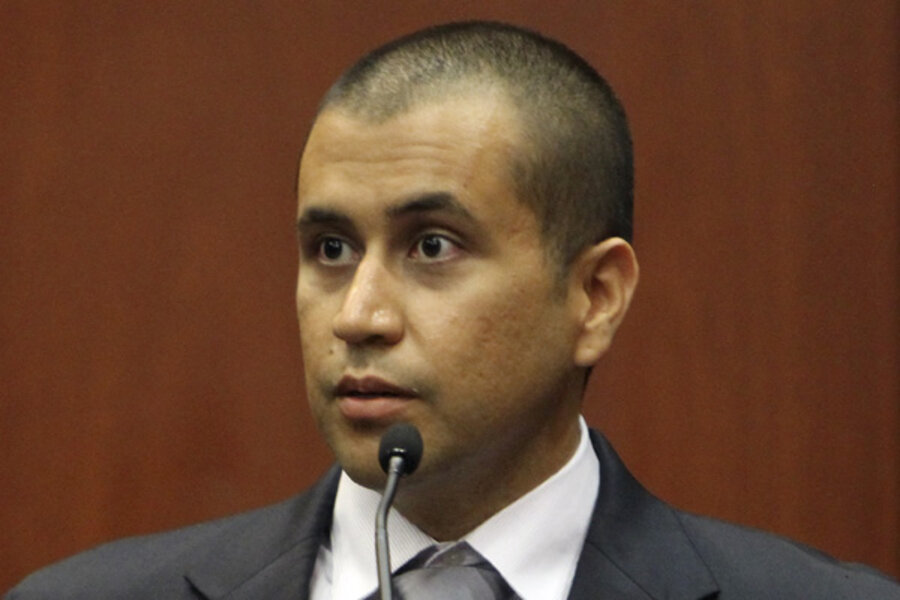Report: Trayvon Martin beat, bloodied George Zimmerman. Game-changer?
Loading...
| Atlanta
Supporters of George Zimmerman, the volunteer watchman charged with murder for shooting Trayvon Martin, say new evidence that shows Mr. Zimmerman was beaten and bloodied about the head and that Mr. Martin’s knuckles were mangled should bolster Zimmerman’s claim that he shot the unarmed black teen in self-defense.
As pieces of evidence in the case begin to trickle out, the second-guessing of the prosecutor’s decision to level second-degree murder charges in the case has begun in earnest, with many seeing Zimmerman’s injuries as a reason to throw the case out altogether.
The evidence, they say, raises questions about whether the decision to charge him at all had more to do with politics rather than facts. A medical report obtained by ABC News states that Zimmerman had a fractured nose, two black eyes, two lacerations on the back of his head, and needed psychological counseling after the fight.
Zimmerman escaped prosecution for six weeks until Gov. Rick Scott – amid a national uproar and the arrival of civil rights leaders – appointed a special prosecutor, Angela Corey, who charged Zimmerman on April 20.
Zimmerman has maintained from the beginning that he feared for his life before shooting Martin. Ms. Corey has said public pressure, including that from civil rights organizations, did not play a role in her decision to charge Zimmerman on April 20, more than six weeks after the shooting.
Evidence that Martin hit Zimmerman hard enough to draw blood from different places on his face and head and skin his own knuckles, according to some legal experts, has made second-degree murder conviction a long shot.
If accurate, the medical report obtained by ABC “is a game-changer,” says Harvard University law professor Alan Dershowitz, who suggests prosecutors acted inappropriately by not referencing the extent of Zimmerman’s injuries in their sworn affidavit to the court.
“A jury that’s not afraid of causing a riot, an objective jury, is not going to convict somebody of second degree murder after his nose was broken, eyes blackened, and his head banged against the ground,” he says.
“The prosecution’s best case is that Zimmerman provoked Martin, absolutely improperly followed him, and confronted him,” Professor Dershowitz adds. “But as a result of that, a battle ensues and Martin’s on top, banging his head against the ground, and [Zimmerman] reasonably believes that his life is at stake and pulls out the gun. It’s classic self-defense, and if it’s not self defense, it’s at worst involuntary manslaughter.”
The new details of the aftermath of the fight, however, are part of shifting perceptions around the case, which led to a national debate on how race plays into increasingly liberalized US gun and self-defense laws.
Initial reports of the fight, accompanied by pictures of Martin as a baby-faced 14-year-old, created the perception of an unbalanced fight between a gun-carrier adult and a young teen. But at the time of the fight, Martin stood at 6 feet 3 inches and 150 pounds, towering over, but not outweighing, Zimmerman, who is 5-foot-8, and 185 pounds. Zimmerman told the court on April 27 that he thought Martin was an adult and said he didn’t know if he was armed or not.
The medical report “doesn’t prove that George Zimmerman acted lawfully, but it breaks the narrative that Zimmerman was not injured,” writes William Jacobson, a Cornell University law professor, on his Legal Insurrection blog.
But while the extent of Zimmerman’s injuries could certainly influence a jury, the injuries are only part of a broader calculus that led Corey and her team to charge Zimmerman with murder – including Zimmerman’s mindset as he pursued Martin on foot, which a police dispatcher specifically asked him not to do. Zimmerman spotted Martin as he was returning to where he was staying with an iced tea and a bag of Skittles.
The Justice Department is also pondering a federal hate crime charge, if they determine that Zimmerman profiled and shot Martin because he was black. A hate crime charge could put the death penalty into play if Zimmerman is convicted on all counts.
In fact, the prosecutor in the case, legal experts say, isn’t trying to argue that Zimmerman wasn’t hurt, but that he ultimately instigated the fight by getting out of his car and “confronting” Martin, who was “minding his own business,” and then shot him and killed him when the situation slipped out of his control. The fact that Zimmerman used massive and deadly force on a teenager armed only with his fists suggests to prosecutors that he displayed reckless – and thus criminal – indifference to human life, the definition of second degree murder.
"You lose the [self-defense argument] if you are the aggressor or if you do not have a reasonable basis for fear or serious harm or death,” George Washington University law professor Jonathan Turley told the Guardian newspaper recently. “Even if he is not the aggressor there will remain the question of escalation or confrontation."








